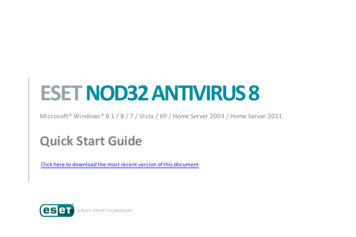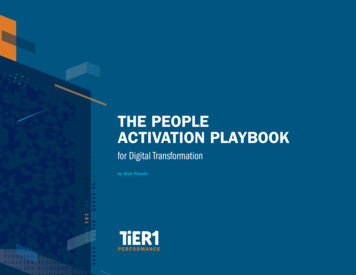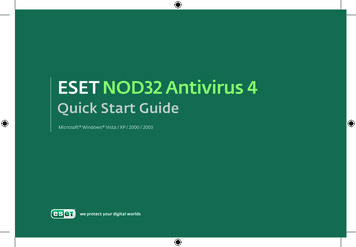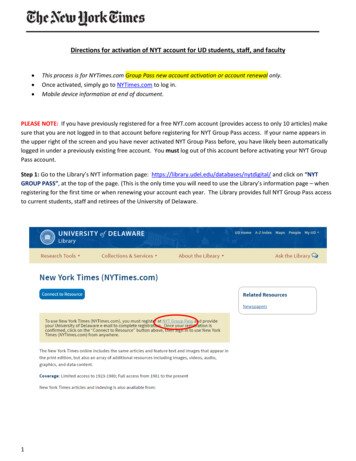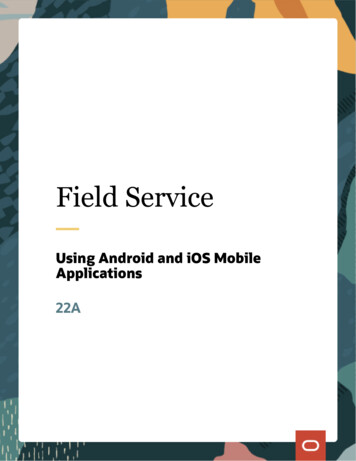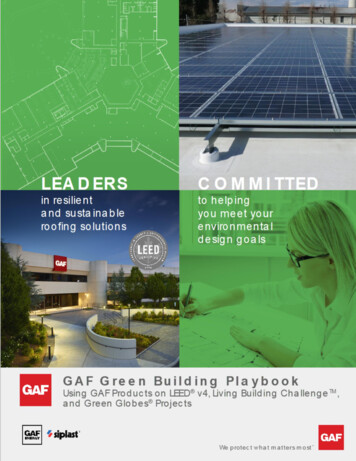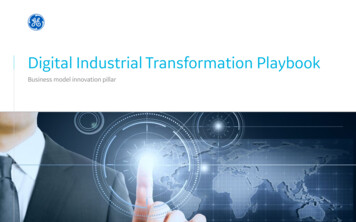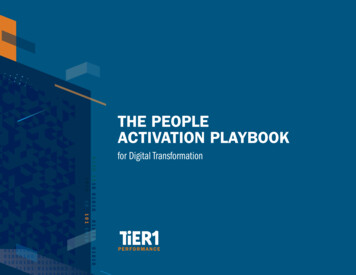
Transcription
THE PEOPLEACTIVATION PLAYBOOK011101100110100101110010011000010100 1010 010100101001010101010 101 1010 01110110000101110100for Digital 1001011101000111001101101111
2WELCOMEOften when the term “digital transformation”comes up, our minds go straight to thetechnologies that are our hopes (and maybesome of our fears) of the world to come.Machine learning, automation, robotics—itoften sounds like the stuff of science fiction.Underneath these technology-centered questions,however, are human-centered concerns: How willevolutions in technology change our jobs, ourorganizations, and our lives?This playbook was created to help you unpackand start to address those human-centeredpossibilities. By breaking down complex conceptsand sharing real-world case studies, we hopeyou’ll begin to see the exciting new frontiers thatdigital transformation can create for your peopleand your organization. Scroll forward to embarkon the journey of taking a people-first approach,so that technology becomes not a threat, but anincredibly powerful tool for increased productivity,connection, and more.TABLE OF CONTENTS03 Intro: Defining Digital Transformation06 Getting Oriented: The 5 People Lensesfor Digital Transformation10 Case Studies: The A Deeper Dive intothe People Lenses12 Conclusion13 Next Steps14 About the Authors
3Digital transformation is a radical rethinking of how people, process,and technology evolve to drive growth in new and existing markets. Yet, the term is so widely used as a concept that its meaninghas become nebulous over time. Rather than getting drawn intothe hype, when we partner to activate strategy through peoplewith our clients, we believe you should claim what words meanto your organization. This is the most important first step whenundertaking large-scale change. INTROWHAT IS DIGITAL TRANSFORMATION? Leaders in the C-suite may use the term “digital transformation”to refer to a variety of activities, including: Automating business processesBetter leveraging existing systems and dataGathering customer insights through digital interactionsInserting smart components in productsMigrating to the cloudModernizing legacy systems Monetizing dataAll of these and more could be part of your digital transformation.While the specific focus can vary, we have identified four keycomponents that come up in every digital transformation.Which of these is true about the changes happening in your organization?Scale of Change: Changes are occurring organization-wide and/or globally, and will havesignificant impacts on culture, organizational structures, roles, relationships, and processes.Mindset Shift: Changes require a fundamental shift in widely held beliefs about whythe work happens and the way work gets done. Investing & Integrating Digital: Changes require aligning, investing in, and/or integratingtechnology and digital skills across all regions to create differentiated ways of doing business.A Response to the Market: Changes are part of an organizational response to digitalopportunities or threats in the marketplace.NOTE: Let these questions be guidelines behind your “why?” of digital transformation. If youanswered “FALSE” to any of the questions, think about exploring if the purpose or the scale ofthe change should be further considered.TrueFalse
WHAT MAKES UP A DIGITAL TRANSFORMATION? Digital transformation is achieved by evolving a new way of thinking about how your people, processes, andtechnology work together to deliver new types of value to customers, employees, and the supply chain. When you think about the areas where your digital transformation is most needed, check off thecomponents that best apply to your HUMAN NETWORKSAGILE QUALITYMANAGEMENTCLOUD TRANSFORMATIONLEADERSHIPAUTOMATED RESOURCEMANAGEMENTDATA ANALYSISSTORYFINANCE INVESTMENTDIGITAL NETWORKSTALENTGOVERNANCEENTERPRISE ARCHITECTUREWAYS OF WORKINGINNOVATION URITYTEAM CONNECTIVITYINTRO4
SUCCESSFUL DIGITAL TRANSFORMATION FOCUSES ON PEOPLEThe meaning of digital transformation can and should shiftas organizations begin to make the term their own. That’s whywhen we talk about digital transformation at TiER1, we hesitateto claim expertise. We prefer to think of ourselves as studentswith experience.One thing we’ve learned along the way is that the conversationalways comes back to people. Innovations like artificial intelligenceand robotic automation have loomed large for decades. For manyworkers, the surge of digital transformation has only amplified theconcern, “Will my job still be here tomorrow?”Our perspective is that pursuing “digital” without the human sideof the “transformation” is the biggest mistake you can make.Rather than technology as threat (think Terminator and HAL 9000)we partner with clients who think of technology as a partner (thinkC-3PO and R2-D2). We believe when our clients embark on a digitaltransformation journey, it should be about extending the potential ofthe frontline, leaders, and their teams —not replacing them. This guide is designed specifically to help you tap into that potential. How TiER1 Defines Digital Transformation Maximizing the intersection of humansand technology to extend potential Applying a digital mindset and culture Developing new organizational habits and individual behaviorsTECHNOLOGYPEOPLEPROCESSESINTRO5
GETTING ORIENTEDWhile the conversation about digitaltransformation starts with technology, it oftencomes back to very human questions. Howare we enabling people to be part of thedigital transformation? What’s getting in ourpeople’s way, when it comes to catching thewaves of the future? And, if we are blockingthe potential of our organization, what canwe do about it? Leadership, mindsets, decision-making,collaboration, habits—these end upbecoming our focus. And for good reason;these questions are important to ask duringany major transformation. In this guide, we’ve identified five peoplelenses that will help you set the recordstraight when it comes to making digitaltransformation a reality through people. 5 LENSES6
5 PEOPLE LENSES FOR DIGITAL TRANSFORMATION Why do we want orneed to transform?Putting people at the center of your digital transformation is critical to ensuringthe success of your organization’s digital future. What do we need totransform?Each of these lenses offers a different angle to ensure your digital transformationis happening with your people and not to them. Who can help us withthe “what?”STORYWhile we recommend balancing any approach by considering all five lenses, yourparticular circumstance might require extra attention to one or two of the lenses. Where do I fit in thenarrative? How do our initiativessupport our digitalstrategy? Who is leading/championing thetransformation? How are leaders being developed tolead digital efforts?LEADERSHIP How do leaders support the cultureshift for the transformation? How are digital initiatives acrossthe organization being coordinated?HUMANNETWORKS How will existing talent learn new digitalskills? What new connection points areneeded to enable the work? How can we think differently aboutcollaboration and transparency inour ways of working? How will we acquire the new talentneeded to accelerate our digital strategy? How are necessary skills beingembedded into strategic areas?TALENT How is knowledge about the changebeing shared and integrated? How will your approach to learning needto evolve? What are the norms (habits and mindsets) that needto change to support Agile and lean processes?WAYS OFWORKING How will change become part of everydayways of working? How are teams adapting to change as itpresents itself?5 LENSES7
5 LENSES8START WITH THE BIG PICTURE VIEWEach organizational transformation (digital or not) is oftencharacterized by a portfolio of initiatives. Your vantage point mightbe across all of these initiatives, or you might be spearheading oneinitiative among many. Either way, transformations are measured bythe total success of the initiatives that make them up.Knowing what your initiatives are trying to accomplish is critical totelling the overall transformation story. Even if you don’t have insightinto other ongoing initiatives, knowing how your work fits into the bigpicture will help you tell your story.When initiatives succeed, they make way for leadership to supportthe next phase of the change. Initiatives that stagnate can becomedistractions and political landmines. Having the discipline to choosewhen to resource initiatives (and when not to) is essential to buildingand maintaining momentum for your transformation.What are your digital initiatives trying to accomplish?Consider the goals of your individual initiatives as well as how they relate to your organization’s overarching strategic goals.OPERATIONSInitiatives focused on improvingthe way work flows to reducecost and/or increase efficiency.NEW CUSTOMERS & MARKETSInitiatives focused on reachingnew customers and pursuingnew market opportunities.SOMETHING IN-THE-MIDDLEInitiatives focused on providingnew value across multiplefronts of the business.CUSTOMER EXPERIENCEInitiatives focused ondelivering value to existingcustomers in new ways.EMPLOYEE EXPERIENCEInitiatives focused onenabling and empoweringemployees in new ways.
5 LENSES9CAN YOU TELL YOUR STORY?Describe the digital transformation.Use the following questions to guide your thinking as you craft yourorganization’s digital transformation story.WHY do we want or need to transform? Why did we see a need to transform?Where do we want to end up (e.g., capabilities, mindsets, know-how)? How will we know we’ve arrived?WHAT do we need to transform? What functions, regions, and businesses are impacted?What relationships, roles, and responsibilities might change?What systems, processes, or technologies might change? What will we do better than anyone else?WHO can help us with the “what”? Who needs to be involved?How might the customer/users be involved?Who can help with building blocks and barriers?Now make your pitch Once you have a digital transformation story down on paper, you’ll need tocommunicate the vision to the rest of the organization. Use these prompts tocreate clear, concise messaging that inspires employee buy-in for the journey.Today, we are embarking on this journey and we have taken ourfirst steps with.In the near-term, we will be focusing on What we know about where we are headed is What we still need to figure out and will be asking for your help with is When we do all this, and learn together along the way, our bettertomorrow could look like When planning an organization-wide change, it’s helpful to thinkabout the entire performance ecosystem. We use PerformanceFactors to determine how the change will impact the individualemployee or employee groups and ensure alignment with broaderorganizational factors. It might be a helpful tool to consider as youcraft your digital transformation story.
A DEEPER DIVEINTO THE PEOPLE LENSESMaybe you recognized some of your ownquestions about digital transformation in oneof the people lenses—or maybe you’re stillunsure about where your organization shouldstart. That’s OK! We’ve been inspired by themany leaders and organizations we’ve partneredwith to navigate the ambiguity. Here are storiesof how these leaders have led with one of thefive people lenses. We hope they motivate newthinking and spark ideas.STORYLEADERSHIPAn inspiring narrative can coordinate thehearts, minds, and hands of an entire workforce.Create a transformation story that is consistentacross your organization to cut down onconfusion and disconnection.Finding and developing the right leaders to stewardyour digital transformation will depend on howcomfortable your organization is currently withdigital technology. Regardless, it is critical to findand retain leaders who can carry out your technicalvision and inspire your teams to action.Case StudyThe Challenge: One organization was about toembark on a multi-year initiative spanning people,process, and technology to shift their organizationtoward a streamlined, digitally-enabled globalshared services model. Rather than focus on theprocess and new technology alone, the team’s firstpriority was to build employee engagement. Thisincluded upfront communication about enlistingemployees’ skills, gathering their ideas, anddrumming up energy.The Result: A story lens allowed the team tobrand and develop a people-focusedcommunication strategy for the transformation.The approach worked to proactively acknowledgeand address potential employee questions andhighlight a framework to support development overtime. It also allowed employees to immediatelycontribute ideas for what the next chapter couldlook like, giving them the power to help shape thenarrative. Tactics to ensure consistency includeda launch video, an idea-sharing platform, andcascaded messaging via leadership.Case StudyThe Challenge: A pharmaceutical leader had amulti-year transformation strategy to acceleratepromising candidates in its R&D pipeline toimprove patient outcomes, meet unmet medicalneeds, and ultimately deliver more valueto patients. This involved transforming thepharmaceutical life cycle. Leaders representingthe value chain spectrum were aligned on amultifunctional effort to break down silos andbuild a cross-functional, collaborative way ofworking, find a healthier balance of risk-taking,and accelerate promising patient-orientedplatforms, all while filtering out interestingbut inapplicable innovations. In the middle ofthe strategy activation, the strong in-personculture was required to continue in a new anduncomfortable virtual environment due to theimpact of a global pandemic.The Result: Equipping leaders with the mindsetsand behaviors to quickly shift from face-to-faceworking sessions to virtual experiences. Byidentifying established quarterly working sessionsand facilitating new ways to gather, explore,collaborate, and plan, we equipped leaders topivot away from traditional, in-person, looselystructured discussions to dynamic, virtual, andtechnology-enabled collaboration. This resulted inthe organization establishing new ways of workingwithout missing a beat.CASE STUDIES10
HUMAN NETWORKSTALENTWAYS OF WORKINGWe’re not talking about networks that connect tothe internet and perform advanced computing—we’re talking about people networks. An emphasison networks helps employees from differentinitiatives collaborate better and back up theirwork with data-driven decision-making.The future of digital talent is a culture ofexponential digital growth. Many teams areaggressively hiring candidates who are proficientin the technologies of today and open to learningthe technologies of tomorrow. Forward-thinkingorganizations are also launching enterprise-widereskilling initiatives to increase learning agilityand build a future-ready workforce.The ways we work are the patterns of teambehavior that make up the course of our days.Whether it’s adjusting to the new normal ofdistributed teams, or finding ways to transitionAgile ceremonies to virtual environments, newways of working is the behavioral solutionthat can help your team fully adopt the digitaltransformation into their everyday work.Case StudyCase StudyThe Challenge: A telecommunications clientwanted to create a learning culture that supportedcapability development, allowing employees toinnovate, perform, and grow in areas alignedwith their personal interests. Curriculum wouldfocus on building “skills of the future,” a mix ofhuman and technical proficiencies. The capabilityacademies would also align to business-criticalstrategies to elevate how employees think and acton the job, support employee growth, and keepthe organization competitive. Overall, the newlearning culture would support the organization’sdigital transformation evolution and employeepreparedness for the digital world.The Challenge: An insurance client wanted totake a new approach to change—rather than topdown communications, the vision was to enablethe workforce to own transformation from thefrontline and become more adaptable by redefiningeveryday behaviors.Case StudyThe Challenge: With 120 unique “snowflake”instances of warehouse management softwareacross 42 locations, a logistics client planned toroll out a single software solution with a solid coreand flexible edges. While the work was focusedon implementing new technology, it also impliedan entirely new approach to the organization’sbusiness model—instead of having almost20 contact points for a client to navigate, thistransformation narrowed it down to three.The Result: A Transformation ManagementOffice that provided a human networks lens, aswell as the necessary governance across therange of initiatives that were needed to activatethis shift. The solution included aligning aportfolio of technology, process, and peopleinitiatives to reduce client touchpoints to threespecialized individuals (commercial, logistics, andengineering) to provide an improved and moreefficient client experience.The Result: A custom, role-based learningarchitecture that enabled multiple learning tracksthat upskilled employees for the transformation.For example, some employees needed to haveonly a basic awareness of data science, whereasothers needed expert level proficiency—thedesign allowed for both tracks. With a digitaltransformation talent lens in mind, we collaboratedwith the team to create an experience thatcomplimented the organization’s existinglearning ecosystem while also creating newopportunities for employees to build digitalpreparedness and learning agility.The Result: A series of immersions that putthe tools of change and behavior redesign intothe hands of the frontline. Together we identifiedthe ways of work that would most enablethe adaptable workforce. A series of culturalinterventions were prioritized to redesign howdaily huddles, new team formation, andcollaboration in the hybrid office could look.CASE STUDIES11
12CONCLUSIONWe hope you found these lenses and casestudies helpful for thinking about yourorganization’s digital transformation and howyou can tap into the potential of your people tobring it to life and realize the business resultsyou’re striving to reach. If you’d like to explorehow TiER1 Performance might partner with youon your journey, here are some waysin which we can help.TiER1 BRINGS A UNIQUEEMPHASIS ON A people-lens to activating digitaltransformation The leader, employee, and customerexperience Integrating mindsets and patterns ofbehavior with digital solutions to createa holistic experience Transforming culture through frontlineapproaches
HOW TO PARTNER WITH TiER1 TOACTIVATE YOUR DIGITAL TRANSFORMATIONWhere TiER1 helps you accelerate Where other partners help you accelerate Transformation roadmaps IT strategy consulting Articulated vision for digital transformation Technology operations design Digital solution and experiencedesign execution Innovation labs Market/competitive benchmarking Digital talent and leadership development Academic partnerships Change management VC and startup partnershipsGETTING STARTED We believe the most successful digital transformations are rooted in the lenses of people. We meetour clients where they are to bring people to the center of the work. Depending on where you are inyour journey, here are a few ways to get started.Explore: A DiscussionIf you’re just getting started or want to hear more, let’s start with a chat to discuss your main areasof interest, need, or opportunity.Immerse: An Acceleration WorkshopIn a team setting, learn about the range of technologies and trends involved in digital transformationand start building your high-level priorities for activating your digital transformation.Activate: A D3 Process (Discover, Define, Design)A D3 allows us to immerse ourselves in your challenge, quickly discovering your current state, anddefining how you envision your future state. Then we collaborate, brainstorm, and strategize toultimately design an experience that will get your organization from here to there. Every D3 has adeliverable—an actionable “blueprint” showing you how to build your desired future state. It’s a visualdepiction of your journey that’s easy to socialize for shared buy-in. It’s a plan you can implement withor without TiER1’s assistance. CONCLUSION13
ABOUT THE AUTHORSNick PinedaDirector of InnovationNick Pineda is the Director of Innovation at TiER1 Performance and is basedin Kansas City. He works with clients to activate transformation at the system,leader, and team levels by designing new ways of working that address cultureas part of practical, day-to-day experiences. Nick translates his passion, energy,and practical experience surfacing the unsaid and unspoken elements of groupbehavior into innovative solutions. He helps clients appreciate strengths andorganize for growth from what’s working today.Brandee AbelPrincipal, Digital & IT SegmentBrandee Abel is a Principal and Strategy Activator at TiER1 Performance who isfocused on collaborating with IT & Digital teams. She loves helping companiesdrive successful change programs and learn how to be more effective driversof change in the process. When she’s not leading change, Brandee lovesrunning half and full marathons.Want to learn more? Let’s ION14
15WE ACTIVATE YOUR STRATEGIEST H R O U G H peopleStrategy is only as valuable as the activation behind it: how it shows up, how work gets done,how your employees own it, and how your customers experience it.HOW WEConsultactivateSTRATEGYDesignBuildIdentify and align on performance factorsneeded for activation.Create the performance experience and everythingneeded to sustain it.Activate strategy through engaging, results-focuseddeliverables.In addition to driving clarity around the desired future state,we partner to understand how the unique dynamics of yourorganization (culture, leadership, roles, systems, etc.) intersectand influence each other to create opportunities and overcomebarriers for successful strategy activation.We deliver the plan and detail needed for your peopleto be empowered and aligned around your strategy:outlining key training, communication, performance supporttools, technology, and associated timelines in a clearlyarticulated blueprint, journey map, or experience design.From custom technology to high-volume communication andtraining, our studio teams of instructional designers, softwaredevelopers, designers, copywriters, and videographers createengaging deliverables that allow your people to have what theyneed when they need it—boom, strategy activated.CUSTOM SOLUTIONS THATactivateSTRATEGYEvery organization has different strategic priorities—and therefore different needs. We custom-craft the solution that is right for you.SYSTEMS ADOPTION DIGITAL TRANSFORMATION EXPERIENCE DESIGN CHANGE STRATEGY ONBOARDING SALES ENABLEMENTPERFORMANCE MANAGEMENT TALENT DEVELOPMENT CUSTOM PORTALS CULTURE CORPORATE COMMUNICATIONStier1performance.com
ACTIVATION PLAYBOOK for Digital Transformation. WELCOME 2 Often when the term “digital transformation” comes up, our minds go straight to the technologies that are our hopes (and maybe some of our fears) of the
